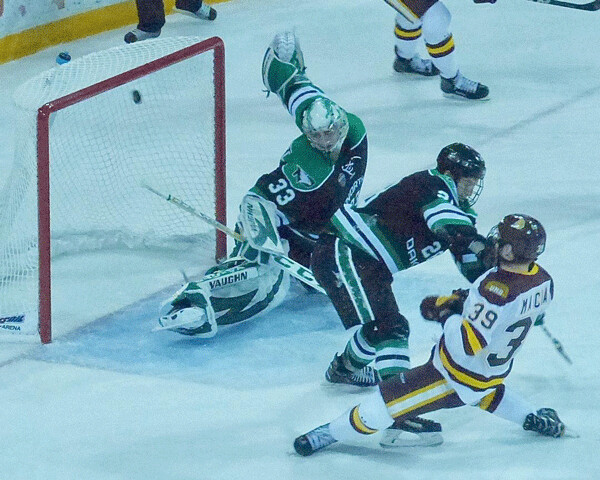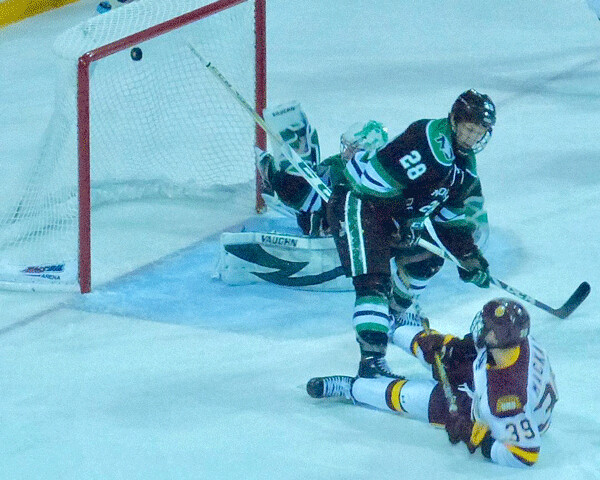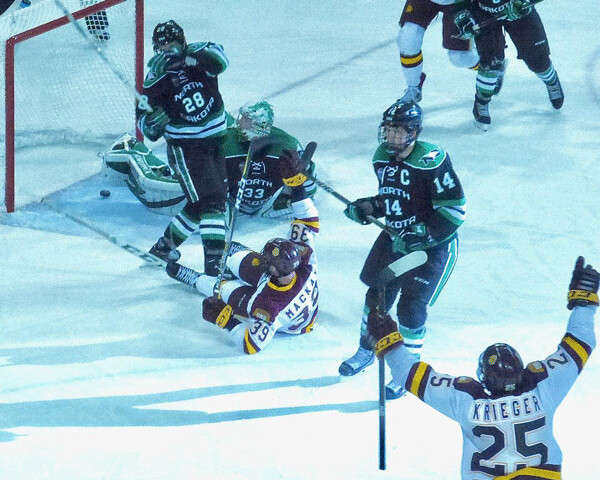News & Articles
Browse all content by date.



Since Minnesota decided to go off and help start the Big Ten hockey conference, the once-intense UMD-Gophers rivalry has been greatly diminished. In its place, the biggest question is which is UMD’s top rival now, North Dakota or St. Cloud State?
We’re about to find out, and in the process find out a lot about this year’s Bulldogs. Even the most ardent Bulldog backers didn’t anticipate a UMD sweep over North Dakota last weekend, but the Bulldogs pulled it off with a strong 5-3 victory on Friday night, followed by a come-from-behind 5-2 triumph Saturday.
The Bulldogs, who were mired in the lower reaches of the extremely tough NCHC two weekends ago, have now swept at Colorado College and at home against North Dakota. And there is no time to relax. This weekend, St. Cloud State’s formerly No 1 Huskies come to AMSOIL Arena for 7 p.m. games Friday and Saturday.
In between, in an act of incredibly bad scheduling, UMD had to go down and play a nonconference game at Minnesota State-Mankato on Tuesday. Nice day off, between the two biggest series of the season. MSU-Mankato just beat St. Cloud State 5-2 last Saturday, and the Mavericks are 18-7 for the season, leading the WCHA.
That game had large bearing on the post-season Pairwise ratings of both UMD and MSU-Mankato, but the Bulldogs mainly wanted to keep rolling as they prepare to face the Huskies.
This weekend, AMSOIL Arena will be busy, because the UMD women, stung by St. Cloud State 3-2 last Friday, and again in a 1-1 tie and shootout loss as part of Hockey Day Minnesota, will try to find new direction in a pair of 3 p.m. games against Ohio State. The Buckeyes just swept two games from Minnesota to take second place in the Women’s WCHA, and will provide a stiff test for the Bulldogs.
In analyzing the men’s Bulldogs, I will repeat how similar their fortunes are to the Minnesota Wild. Both teams had a few injury problems early, and both teams are now healthy and hitting full stride. Both also share one strange similarity: Neither has a genuine sniper, which sometimes leaves both of them shy of goal-scoring, but also might work itself out into proving that scoring by committee could be preferable.
North Dakota came to town in a similar fix. Brock Boeser and Tyson Jost both signed pro contracts after last season. Jost, who I thought was the most exciting player in college hockey last year, is playing for the streaking Colorado Avalanche in the NHL. Boeser, whose scoring was inhibited by injuries, is a flyer who can score at the next level. He has 22 goals halfway through his rookie season with the Vancouver Canucks, and could be rookie of the year in the NHL.
Without them, the Fighting Hawks have had to work and press and play off each other to manufacture goals, same as UMD. The teams battled to a 1-1 standoff through one period Friday, with Joey Anderson’s short-side wrist shot from the left circle getting a goal for the UMD power play, only to have North Dakota counter on a rebound goal by former Duluth East winger Trevor Olson, also on a power play, gained when UMD’s Avery Peterson was awarded his second of three first-period penalties.
Peter Krieger restored the lead to UMD midway through the second, hitting the far side from the right circle. Then Parker Mackay deflected in another power-play goal for a 3-1 Duluth lead. Grant Mismash got one back for North Dakota in the first minute of the third period, cutting it to 3-2 just after Peterson’s carryover fourth penalty expired.
That inspired the Fighting Hawks to come on strong, but UMD captain Karson Kuhlman made a neat move to pull the puck to the slot and got his full force behind a blast that caught the left edge at 1:56, and it was 4-2. Without a doubt, it appeared that North Dakota had taken the game over, however, and UND coach Scott Sandelin took a judicious time out to suggest to his troops that the third period had, indeed, started.
Colton Poolman got a deflection goal at 3:52, however, and it was 4-3 and time to hang on. UMD had to kill a couple of penalties later in the third period, and at 18:45, the Bulldogs got one of the oddest power plays. North Dakota goaltender Cam Johnson waited for his chance to come off for a sixth attacker with two minutes left, and when he got the chance, he skated for the bench as a Hawk attacker came on. Just then, Cam Johnson saw UMD had a promising attack going toward his emptied net, so he doubled back and hustled to return to the net.
Zap. Too many men on the ice at 18:45, and the Bulldogs had a powre play that helped defuse the Fighting Hawks until Riley Tufte could shoot into an empty net for the 5-3 clincher.
Enough times to become traditional, two evenly matched teams play a two-game series, and whichever loses the first game has just enough incentive to win the second game and gain a split. This time, it looked like another chapter of that book, when Shane Gersich broke in on UMD goalie Hunter Shepard, who blocked his break in but had no chance on Gersich’s bang-bang rebound shot at 6:36. North Dakota’s Austin Poganski maneuvered to the slot and snipes a perfect shot into the upper left corner just 30 seconds later, and it was 2-0.
Seemingly unbothered by the 2-0 deficit, the Bulldogs killed another penalty and then Jared Thomas wound up with a goal when the puck bounced in off his leg, cutting the deficit to 2-1 at the first intermission.
Then a positive sign for the Bulldogs came when, after seeming to run out of gas in the third period Friday, they stormed out and peppered North Dakota with a 17-3 barrage of shots in the second. Scott Perunovich, UMD freshman defenseman who has led the team in scoring most of the season, acored at 5:58 on a two-man power play, which cut the man-advantage to one man, prompting Perunovich to go deep up the left side and score from wide left at 6:14 — two goals in 16 seconds for the prolific rookie, and those goals vaulted UMD into a 3-2 lead.
It stayed that way until midway through the third period, when Parker Mackay scored a definite highlight video goal to boost the Bulldogs to a 4-2 lead. Mackay was in front, on the left side, when Joey Anderson’s rebound came to him. As he was about to shoot, North Dakota defenseman Hayden Shaw hit him with a face-on bodycheck, knocking Mackay on his backside.
As a goal-scorer, Mackay knew he was going to get hammered, but flipped his shot up high as he was blasted. The puck went under the crossbar into the roof of the net as Mackay went down, and it ricocheted back out as he landed on his back. It was a huge goal, making it 4-2, and Mackay, a junior from Irma, Alberta, raised his arm in celebration while still flat on his back.
North Dakota coach Brad Berry pulled Cam Johnson for six attackers with 3:48 remaining, knowing he needed two goals to catch up, but UMD’s hustling Bulldogs kept coming up with the puck and clearing. Four times they tried to hit the empty net, but failed. Finally, on the fifth try, Riley Tufte shot one into the net with 11 seconds remaining, securing UMD’s 5-2 triumph.
“We knew they’d come out strong, and they did,” said UMD coach Sandelin. “And they’re a great transition team, so we knew they’d push back, and they did.”
For the weekend, sophomore Joey Anderson had the first goal of the weekend, added an assist in the first game, then had four assists in the second game. Tufte, the empty-net maestro, had one each night and now leads the Bulldogs with 12 goals, while Peter Krieger has 8, Mackay 7, Perunovich and Thomas 6, with 5 each by Joey Anderson, Kuhlman, Blake Young and Avery Peterson, who sat out Saturday to ponder his goals/penalties relationship.
Definitely, scoring by committee.
Sad Week In Hockey
The joy all of us hockey fans get from the game, and from successful teams winning big games in spectacular fashion, came into jarring perspective last week.
First, I heard that Red Fisher had died. Red was a fixture on the NHL scene, writing for the Montreal Gazette as its hockey writer through the glory days of the Montreal Canadiens. He was somehow a combination of clever, direct, cynical and beloved during his long career, which ended years ago. He died in Montreal at age 91.
Next came the shock that Jim Johannson, general manager of the U.S. Olympic hockey team for the upcoming Korean Winter Olympics, died in his sleep at his home in Colorado Springs. He was 53, and nobody suspected any health issues. I first met Jim and his older brother John with their dad, Kenny Johannson, who served as general manager for various USA national teams. He was efficient and served the nation’s amateur hockey programs well, as he and his wife raised their family in Rochester. Both John and Jim played hockey at Rochester Mayo and then the University of Wisconsin, and after giving pro hockey a try, Jim Johannson became involved in USA Hockey. In a sport and administrative tangle that often led to hostile attitudes, Jim was a beacon of fair play and grass-roots loyalty to the sport he loved. Various Wild players played on teams under his administration, and this year, he had particularly important duties as the NHL withheld its players from the U.S. team and he led the way in scouting and selecting the players for the Olympic team less than a month from the Games.
Next came the jolt that Andrew Carroll, who grew up in Shoreview where I lived for three decades, and who came to UMD and wound up as a four year player a decade ago, and he was liked by everyone he played with and who was in contact with him. Carroll died, we’re told,that Carroll’s death at Chicago OHare was suicide. Carroll, 32, played hockey for UMD from 2005 through 2009. Another sudden and jarring death in the hockey community.
Monday night, I heard that Whitey Aus, long-time boys hockey coach at Kellogg High School in Roseville, and later coach of the St. Olaf team, also died. I have no more details, and I don’t know how many more sad details I can cope with.
| Tweet |


